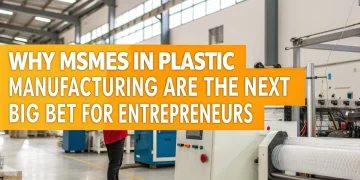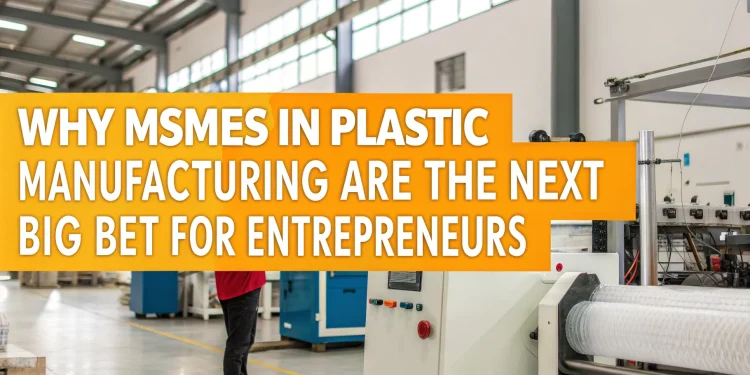The MSME sector has been one of the pillars of industrial development in India. It comprises more than 63 million units in the country and contributes around 30% of India’s GDP alongside 45% of the country’s exports. It employs more than 110 million people. Out of these, plastic manufacturing MSMEs are one of the most vibrant industries and are witnessing significant growth.
Nearly all components of the economy are served by the plastic manufacturing sector, from packaging and consumer goods to automotive and even healthcare products. Despite trade fluctuations and other global challenges, the sector is robust and shows growth. India’s exports of plastic products hit USD 11.54 billion in 2023-2024, as per The Plastics Export Promotion Council of India, and MSMEs played a prominent role in value-added plastic exports.
For entrepreneurs and startups, this presents a unique opportunity. Micro, Small, and Medium Enterprises (MSMEs) within the plastic manufacturing sector are not simply small-scale operations anymore. They are transforming into sophisticated and innovative enterprises with a strong focus on exports and advanced technology. In this article, I discuss my reasons for believing that entrepreneurs should focus on plastic manufacturing MSMEs, along with the supporting data, government policies, and anticipated market value.
Strategic Importance Of MSMEs In Plastic Manufacturing
MSMEs within the plastic sector have a distinctive place in India’s economy, as they have a unique combination of three important Edgems.
- Geographical Spread: MSMEs have a presence in urban centers such as Gujarat, Maharashtra, and Tamil Nadu, as well as in semi-rural areas, which helps achieve balanced industry dispersion.
- Product Diversification: From simple household items to sophisticated composite materials and plastics used in medicine, the MSMEs cater to several industries.
- Focus on Exports: Small and medium enterprises dominate the exports of value-added plastics from India (67.5% of total).
With these advantages, MSMEs are crucial not only for domestic demand but also for the integration of India into the global supply chain.
Related: India’s Untapped $479 Million Opportunity: The FRP Composites Revolution
Market Outlook & Growth Possibility
Driven by MSMEs, the sector of plastic manufacturing is anticipated to experience rapid growth in the upcoming decade.
Market Forecast Overview (India & Globally)
| Market Segment Overview | 2023 Value (USD Billion) | Projected 2030 Value (USD Billion) | CAGR (2023–2030) |
| Global Plastics Market | 610 | 810 | ~4.5% |
| India Plastics Industry | 32 | 54 | ~7.8% |
| MSME Share in India’s Plastics | 20 | 35 | ~8–9% |
| Export-Oriented MSMEs Contribution | 7.8 | 15 | ~9% |
Key Insight: MSMEs in India’s plastics industry are poised to increase their production capacity nearly twofold by 2030 due to rising domestic consumption in packaging, construction, and FMCG sectors and exports of medical plastics, composites, housewares, films, and packaging materials.
View our Books on Plastics and Polymers,Polyester Fibers, Pet & Preform, Medical, Expanded Plastics, Polyurethane, Polyamide, Polyester Fibers, Additives, Colourants and Fillers, Extrusion, Moulding, Mould Designs, Optical Glass, Reinforced, Films, HDPE, Thermoset

Performance of India’s Plastic Exports (2023–24)
India’s plastic exports are detailed in The Plexconcil Annual Report 2023–24.
Export Composition (USD Million):
| Product Category | 2023–24 Value (USD Million) | Growth % | Share of Total Exports (%): |
| Plastic Raw Materials | 2,984.95 | -10.16% | 25.87% |
| Value Added Plastics (MSME Driven) | 7,790.58 | -2.14% | 67.51% |
| Consumer & Houseware | 827.40 | +9.93% | 7.17% |
| FRP & Composites | 479.22 | +12.72% | 4.15% |
| Medical Items of Plastics | 536.86 | +8.91% | 4.65% |
| Packaging Items (Flexible & Rigid) | 633.74 | +1.43% | 5.49% |
| Miscellaneous Products & Items (NES) | 715.48 | -30.67% | 6.20% |
Why the Plastic Sector MSMEs are a Startup Goldmine
- High Domestic Consumption
Demand for plastic consumer goods and specialized plastic items are a result of flourishing sectors like FMCG, e-commerce, healthcare, and also automobiles.
Export Growth Potential
Even in harsh economic climates, the medical and composite plastic industries tend to flourish, as noted by medical plastic and composite exports growing 8.9% and 12.7% respectively. These are some of the global niches MSMEs are targeting.
Innovation & Sustainability Shift
Recycled goods, circular economy structures, and biodegradable plastics are some of the products and models that give global market competitive advantage to startups.
Government Policy Push
Entrepreneurs are offered direct incentives to scale plastic manufacturing for MSMEs and the Foreign Trade Policy 2023 plastic manufacturing scale policy.
Cluster-Based Growth
The skills and resources for exporting are being met by regions like Gujarat, Tamil Nadu, Maharashtra, and Odisha, where plastic MSMEs are growing and specializing.
Related: India’s Medical Plastic Exports Goldmine: A Startup Opportunity You Can’t Miss
Government Policy Support for Plastic MSMEs
The Government of India has taken multiple steps to strengthen MSMEs in the plastics sector:
- Foreign Trade Policy 2023: Focused on exports of value-added and eco-friendly products.
- EPR (Extended Producer Responsibility): Promotes green and recycling practices.
- MSME Subsidy Schemes: These grants assist MSMEs in acquiring machinery, infrastructure, as well as, patent registration and participation in global trade shows.
- Skill Development Programs: Plastic processing is taught through CIPET and MSME institutes.
- Trade Fairs and Reverse Buyer-Seller Meets: Plexconcil sponsored and organized PLEXCONNECT 2023, which generated USD 16.3 million in trade inquiries in only three days.
Start-up Opportunities in Plastic Manufacturing MSMEs
- Packaging Materials
- Flexible films, rigid containers, and biodegradable packaging.
- Increased e-commerce and FMCG demand.
- Medical Plastics
- Syringes, IV tubes, diagnostic kits, and PPEs.
- Strong global demand with double-digit export growth.
- FRP and Composites
- Automotive panels, pipes, and components for renewable energy.
- Fastest-growing niche in India’s exports.
- Consumer Housewares and Stationery
- Low-cost, high-demand products for exports and the domestic market.
- Recycling and circular economy ventures
- Recycled plastics for green packaging and other industrial uses.
Investment Feasibility Snapshot
NPCS research provides the following financial overview for a plastic MSME manufacturing plant with a 10 MT/day capacity.
| Investment Head | Estimated Cost (INR Million) |
| Land & Building | 20–25 |
| Machinery & Equipment | 30–40 |
| Raw Materials (Working Capital) | 10–12/month |
| Utilities & Miscellaneous | 5–7 |
| Total Project Cost | ~ 65–75 |
Typical Financial Indicators:
- Payback Period: 2.5–3 years
- IRR: 25–30%
- DSCR: 1.9–2.2
Role of Niir Project Consultancy Services (NPCS)
The plastic MSME sector offers structured feasibility assessment and strategic business guidance.
- Niir Project Consultancy Services (NPCS) prepares Market Survey cum Detailed Techno-Economic Feasibility Reports.
- Their reports encompass process computation for manufacturing, raw materials, plant layout, and intricate financial analyses.
- NPCS aids entrepreneurs in evaluating feasibility and data-backed decisions before making investments, ensuring startups are profitable.
- Niir Project and Consultancy Services serves as a knowledge partner for plastic MSMEs as well as a guide for domestic and international businesses for export-related ventures.
Plastic MSMEs Opportunities Infographic Description (2030-2024)
Projected Growth Share
- 30% for Packaging
- 20% for medical-grade plastics
- 15% for FRP & Composites
- 20% for Household Consumer Products
- 15% for Recycling & Green Plastics
- 15% for Green Plastics
Obstacles for MSME Entrepreneurs
- Volatile Raw Materials: The price of polymers and resins fluctuates with crude oil price changes.
- Global compliance standards: Exports require certifications, including US FDA, EU EFSA, and ISO.
- Technology adoption: There is a need for investment in advanced molding, 3D printing, and digital competitiveness.
- Capital access: There are ongoing issues with financing and working capital management for MSMEs.
Looking Ahead (2025-2030)
India’s plastic MSMEs are on track to achieve nearly double their output by 2030.
By 2030, export-oriented MSMEs are forecasted to hit $15 billion. Demand for medical-grade plastics, FRP, and packaging is the driving force.
Domestic MSMEs focused on green sustainability will receive expedited policies and customer support.
For startups, the next ten years serve as a significant opportunity to launch and expand Micro, Small, and Medium Enterprises (MSMEs) in the plastic manufacturing sector.
Find the Best Idea for Yourself With our Startup Selector Tool
FAQs
Q1. Are plastic MSMEs still viable given environmental concerns?
A: Yes. The future lies in value-added, recyclable, and biodegradable plastics, where MSMEs are already innovating.
Q2. What are the most profitable MSME ventures in plastics today?
A: Packaging, medical plastics, FRP composites, and recycling ventures are leading in profitability.
Q3. How much investment is needed to start a plastic MSME unit?
A: Typically INR 60–75 million, with payback in 2–3 years and IRR of 25–30%.
Q4. Do MSMEs get export assistance?
A: Yes. Through Plexconcil, the Ministry of Commerce supports participation in global trade fairs, buyer-seller meets, and export incentives.
Q5. Can small-scale entrepreneurs compete with large plastic manufacturers?
A: Absolutely. MSMEs thrive on niche products, flexibility, and export-driven demand, where agility matters more than scale.
Conclusion
The MSME plastic manufacturing sector is India’s next growth frontier. With strong domestic demand, resilient exports, and government-backed policy frameworks, it presents unmatched opportunities for startups and entrepreneurs. Whether in packaging, composites, or medical plastics, MSMEs are at the heart of India’s value-added export story.
Armed with insights from The Plastics Export Promotion Council and strategic guidance from NPCS, entrepreneurs can confidently enter this sector, build scalable ventures, and contribute to India’s global leadership in sustainable and value-added plastics.
The verdict is clear: plastic MSMEs are the next big bet—and the time to act is now.


















